Michael J. Behe's Blog, page 576
October 31, 2018
Probability of a single protein forming by chance
Hat tip: Philip Cunningham
April 7, 2017
Copyright © 2018 Uncommon Descent . This Feed is for personal non-commercial use only. If you are not reading this material in your news aggregator, the site you are looking at is guilty of copyright infringement UNLESS EXPLICIT PERMISSION OTHERWISE HAS BEEN GIVEN. Please contact legal@uncommondescent.com so we can take legal action immediately.
Plugin by Taragana
Neutrinos test the Standard Model of particle physics
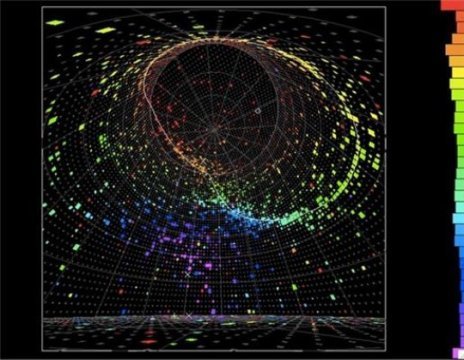
electron-neutrino interaction/(AEC, Laboratory for High Energy Physics
“Tested and verified with ever increasing precision,” the Standard Model is a a remarkably elegant way of understanding the relationships between particles and their interactions.” But then there are the neutrinos:
In the Standard Model, neutrinos come in three kinds, or flavors: electron neutrinos, muon neutrinos and tau neutrinos. This mirrors the other matter particles in the Standard Model, which each can be organized into three groups. But some experiments have shown hints for a new type of neutrino, one that doesn’t fit neatly into this simple picture.
…
This extra neutrino—suggested by results from the Liquid Scintillator Neutrino Detector and the MiniBooNE experiment—wouldn’t match up with the generations of particles in the Standard Model. It would be “sterile,” meaning it likely wouldn’t interact directly with any Standard Model particles. It might even be a form of dark matter.
Whether or not extra neutrino flavors exist, neutrinos have already shown us that they sit beyond the bounds of ordinary physics in other ways.
According to the Standard Model, neutrinos should be massless. But they aren’t; they have strangely small masses that don’t seem to fit in with the masses of the rest of the fundamental particles.
This fact could possibly be accounted for by a tweak in the theory. Or it could have deep implications for our understanding of the universe. Matthew R. Francis, “Already beyond the Standard Model” at Symmetry
Past experience suggest that it will require only a tweak in the theory. This doesn’t sound as frustrating as the search for dark matter.
Follow UD News at Twitter!
See also: Clue about antimatter: Does it depend on how neutrinos behave vs. antineutrinos?
Also:
Electron’s nearly perfect roundness stymies the search for “new physics”
Researchers: Bizarre Antartic particles might shatter modern physics
and
Researchers: Fewer galaxies have formed since the Big Bang than should have
Copyright © 2018 Uncommon Descent . This Feed is for personal non-commercial use only. If you are not reading this material in your news aggregator, the site you are looking at is guilty of copyright infringement UNLESS EXPLICIT PERMISSION OTHERWISE HAS BEEN GIVEN. Please contact legal@uncommondescent.com so we can take legal action immediately.
Plugin by Taragana
Stone tools found in Saudi Arabia from 300,000 years ago
At the time, Saudi Arabia was a grassy plain with many lakes:
Archaeologist Patrick Roberts of the Max Planck Institute for the Science of Human History and his colleagues recently discovered a handful of stone tools in a sandy layer of soil beneath the dry traces of a shallow Pleistocene lake at Ti’s al Ghadah, in the Nefud Desert of northern Saudi Arabia. The soil layer dated to between 300,000 and 500,000 years ago, and it also contained fossilized remains of grazing animals, water birds, and predators like hyena and jaguar. Many of the bones seem to bear the marks of butchering by tool-wielding hominins. Kiona N. Smith, “Archaeologists find 300, 000-year-old stone tools in Saudi Arabia” at Ars Technica
On account of finds like this, some think that humans also lived in North America 100kya. The evidence may be ambiguous but the idea is not simply impossible.
Follow UD News at Twitter!
See also: New find extends back our knowledge of earliest identified North Americans Science News: Early American settlers crafted stemmed spearpoints and probably traveled down the Pacific coast starting around 16,000 years ago, the researchers contend.
First North Americans might have been Neanderthals, 130 kya…
and
Were there humans in North America 100 thousand years ago?
Copyright © 2018 Uncommon Descent . This Feed is for personal non-commercial use only. If you are not reading this material in your news aggregator, the site you are looking at is guilty of copyright infringement UNLESS EXPLICIT PERMISSION OTHERWISE HAS BEEN GIVEN. Please contact legal@uncommondescent.com so we can take legal action immediately.
Plugin by Taragana
October 30, 2018
New find extends back our knowledge of earliest identified North Americans
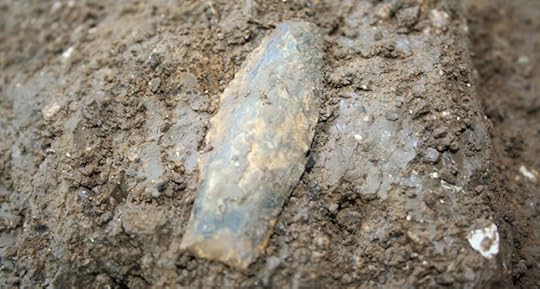
15,000-year-old spear point found in Texas/Center for the Study of the First Americans/Texas A&M
Artifacts have been found from a group that may have contributed to the later and better known Clovis culture:
“We have discovered two previously unknown spearpoint styles that predate Clovis,” says study coauthor and archaeologist Michael Waters of Texas A&M University in College Station. Finding these artifacts in sediment showing a clear progression from stemmed points to a triangular point to Clovis points over a roughly 2,000-year period raises the likelihood that one spearpoint style led to the next, Waters holds.
Similar stemmed spearpoints dating to as early as around 14,000 years ago have been found in parts of the western United States (SN: 8/11/12, p. 15). Several spearpoints found at the Gault site in Central Texas, dating to 16,700 years ago or more, also look similar to the stemmed spearpoints from Buttermilk Creek, Waters says.
Early American settlers crafted stemmed spearpoints and probably traveled down the Pacific coast starting around 16,000 years ago, the researchers contend. Bruce Bower, “Ancient Clovis people may have taken tool cues from earlier Americans” at Science News
Follow UD News at Twitter!
See also: Were humans in North America 130,000 years ago? Some evidence considered
Were there humans in North America 100 kya? Or was the find just heavy construction equipment damage?
First North Americans might have been Neanderthals, 130 kya…
and
Were there humans in North America 100 thousand years ago?
Copyright © 2018 Uncommon Descent . This Feed is for personal non-commercial use only. If you are not reading this material in your news aggregator, the site you are looking at is guilty of copyright infringement UNLESS EXPLICIT PERMISSION OTHERWISE HAS BEEN GIVEN. Please contact legal@uncommondescent.com so we can take legal action immediately.
Plugin by Taragana
Landmark origin of life conference videos resurface
 From Suzan Mazur, author of The Origin of Life Circus and The Paradigm Shifters: Overthrowing ‘the Hegemony of the Culture of Darwin’, links to some vintage films of origin of life conferences funded by chemist Harry Lonsdale (1932–2014):
From Suzan Mazur, author of The Origin of Life Circus and The Paradigm Shifters: Overthrowing ‘the Hegemony of the Culture of Darwin’, links to some vintage films of origin of life conferences funded by chemist Harry Lonsdale (1932–2014):
Before he died Harry Lonsdale sent me a package with his book on politics—Running: Politics, Power, and the Press—and a flashdrive of his 2013 meeting with the origin of life research teams he funded. I assume he wanted me to share. Following in four parts is Lonsdale’s 2013 origin of life video conference with John Sutherland, Matt Powner, Dave Deamer, et al. The original link to the meeting seems to have disappeared from the Internet. Of particular interest—John Sutherland’s presentation and Nick Hud’s comments about Niles Lehman’s research. Suzan Mazur, “Harry Lonsdale’s Origin of Life Video Conference w/ Sutherland, Powner, Deamer, Lehman et al.” at Oscillations
Follow UD News at Twitter!
See also: Çatalhöyük, a window on life 9,500 years ago (Suzan Mazur)
Suzan Mazur on mechanobiology, the next level of understanding of the cell
Might Earth’s deep subsurface be “brimming with life”?
and
Those most ancient Greenland “fossils” are not really life, new team says
Copyright © 2018 Uncommon Descent . This Feed is for personal non-commercial use only. If you are not reading this material in your news aggregator, the site you are looking at is guilty of copyright infringement UNLESS EXPLICIT PERMISSION OTHERWISE HAS BEEN GIVEN. Please contact legal@uncommondescent.com so we can take legal action immediately.
Plugin by Taragana
Fruit fly study casts doubt on the “carbs are bad” neutral evolution theory
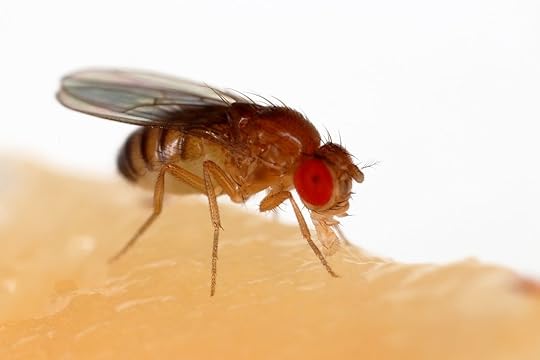
fruit fly/Sanjay Acharya (CC BY-SA 4.0)
From ScienceDaily:
Fruit fly research challenges neutral theory of molecular evolution and suggests one day we may be prescribed diets according to our genes.
Fruit fly larvae with a noted mitochondrial DNA (mtDNA) mutation showed a pronounced increase in development when eating high carbohydrate diet of banana, but stagnated on a high protein diet of passionfruit.
Conversely, fruit fly larvae without the mtDNA mutation thrived on the high protein diet, but dropped in frequency when put on carbohydrates.
UNSW School of Biotechnology & Biomolecular Sciences Professor Bill Ballard, who led the study, says the research is a rare demonstration of positive selection at work in evolution.
“What is unique about this study is we’ve identified one mutation in the mitochondrial genome, that when fed a specific diet is advantageous and causes the frequency of flies in a population cage to increase,” he says.
Carbohydrates are not supposed to be better than proteins for this purpose.
Given that humans share 75 per cent of the same genes as fruit flies, and have the same mtDNA genes, it is certainly an intriguing prospect that the same mutation inherited in human mtDNA may metabolise carbohydrates in a similar way.
Professor Ballard says while confirmation of this would be “another NHMRC grant away and years of surveying and testing,” the idea is worth exploring.
He says knowledge of a person’s ‘mitotype’ could help explain why a diet high in carbohydrates may induce obesity and diabetes in some but not others. Paper. (from authors) – Wen Chyuan Aw et al. Ad Genotype to phenotype: diet-by-mitochondrial DNA haplotype interactions drive metabolic flexibility and organismal fitness. PLOS Genetics, 2018 More.
Follow UD News at Twitter!
See also: New findings challenge the “neutral” theory of evolution for 95% of human genome Perhaps the most reasonable conclusion is that all of Darwinism is in a mess similar to that of speciation.
Dollo’s Evolution Law gets hit again: Stripes come and go What conceptual myths like Dollo’s Law mainly explain is this type of thing: “Museum director: Darwin’s theory of evolution not only underpins all biological science, it has an immense predictive power.” That is, increasingly, the only feature of the evolutionary landscape that Darwinian concepts shed light on is the behavior of the believers and enablers, the doubters and dissidents, and people who just can’t afford to lose their job.
and
Tortoise study does not support textbook “island rule” for evolution The researchers are unsure why giant tortoises thrived on islands but one suggestion is that they were already big and as a result, they were better able than smaller tortoises to reach remote islands.
Copyright © 2018 Uncommon Descent . This Feed is for personal non-commercial use only. If you are not reading this material in your news aggregator, the site you are looking at is guilty of copyright infringement UNLESS EXPLICIT PERMISSION OTHERWISE HAS BEEN GIVEN. Please contact legal@uncommondescent.com so we can take legal action immediately.
Plugin by Taragana
The failed search for an evolutionary morality
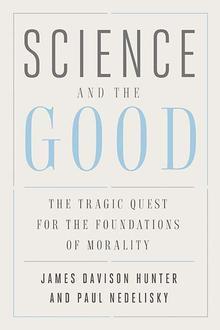 Richard Weikart, author of The Death of Humanity And the Case for Life, reviews James Davison Hunter and Paul Nedelisky’s new book, Science and the Good: The Tragic Quest for the Foundations of Morality
Richard Weikart, author of The Death of Humanity And the Case for Life, reviews James Davison Hunter and Paul Nedelisky’s new book, Science and the Good: The Tragic Quest for the Foundations of Morality
There are many scientific problems with this project. Hunter and Nedelisky, however, only rarely point out the empirical difficulties. (They do point out the problems with Paul Zak’s claims about a “moral molecule.”) This is likely for the sake of argument. However, their critique would have been stronger if they had asked more questions about the scientific evidence. Instead, for the most part they accept the descriptive claims.
However, they still point out a glaring problem. Many of these “moral scientists” overreach by making prescriptive claims. They express moral approval or disapproval for certain behaviors. This misleads many people into thinking they are making real moral claims. However, they have redefined morality by rejecting moral realism.
Why all this confusion? Part of the reason, I think, is that the “moral scientists” are themselves conflicted. Their naturalistic approach tells them one thing: Morality has no objective reality. However, their conscience and experiences tell them something else: Some moral positions really are superior to others.
In my book, The Death of Humanity, I provide many examples of intellectuals who dismiss morality as non-objective. However, in their real life they are fanatically committed to moral positions. Richard Weikart, “Science and the Good: Can Science Help Us Learn How to Live?” at The Stream
Actually, rejecting moral realism makes a lot of sense if people plan simply to impose morality by rigid rules and constant surveillance. Then, they can’t be questioned even if the system is suddenly reprogrammed at the drop of a hat.
Follow UD News at Twitter!
See also: Richard Weikart on the anti-Semitic burst in evolutionary psychology
and
The Subjectivists Are Good at Emoting; Arguing, Not So Much (Barry Arrington)
Copyright © 2018 Uncommon Descent . This Feed is for personal non-commercial use only. If you are not reading this material in your news aggregator, the site you are looking at is guilty of copyright infringement UNLESS EXPLICIT PERMISSION OTHERWISE HAS BEEN GIVEN. Please contact legal@uncommondescent.com so we can take legal action immediately.
Plugin by Taragana
October 29, 2018
Fine-tuning: Is Earth’s magnetic core special too, compared to Mars’s?

Mars/NASA
Physicist S. Fred Singer offers some suggestions pertaining to the hunt for life on Mars:
1. Super-rotation of the core
Seismic data, taken over a period of several years (Zhang, et al., Science 2005), suggest that the (innermost, solid iron) core is rotating slightly faster than the rest of the Earth, at 0.3-0.5 degrees/yr. We don’t know if this super-rotation is constant or varies over time. The analysts did not suggest a cause, hence relatively little attention has been devoted to the phenomenon. Most scientists I talked to had never heard of it.
2. Possible explanation of super-rotation
If I invert the question and ask, “Why is the Earth rotating slower than its core?,” then the answer becomes clear to me, and I can even calculate and estimate its magnitude. The slowing down may be caused by tidal friction, produced by the Moon. This also means that the super-rotation has been going on for billions of years.
…
6. We may assume that similar processes happened on Mars. I believe that its core was liquefied by tidal friction, but it has cooled and is no longer liquid. Mars no longer has a general magnetic field like the Earth. Its magnetosphere has now disappeared, but its shielding effect may have lasted long enough, I believe, to maintain an ocean on Mars’s surface for some time.
7. Lundin and others have measured the removal of the Martian upper atmosphere by the sweeping action of the solar wind. The crucial question is this: did the Mars atmosphere and surface ocean exist long enough to permit the creation of life forms – as it did on Earth? S. Fred Singer, “Calculating life on Mars” at American Thinker
So he is hoping to find “either krypto-life or paleo-life, just below the Martian surface.”
Follow UD News at Twitter!
See also: The early universe was flat to a “suspicious” one part in a million Hence cosmic inflation theory, promoted with some pretty wild theorizing
and
What becomes of science when the evidence does not matter?
Copyright © 2018 Uncommon Descent . This Feed is for personal non-commercial use only. If you are not reading this material in your news aggregator, the site you are looking at is guilty of copyright infringement UNLESS EXPLICIT PERMISSION OTHERWISE HAS BEEN GIVEN. Please contact legal@uncommondescent.com so we can take legal action immediately.
Plugin by Taragana
Might snakes provide a way of testing Dawkins’s selfish gene hypothesis?
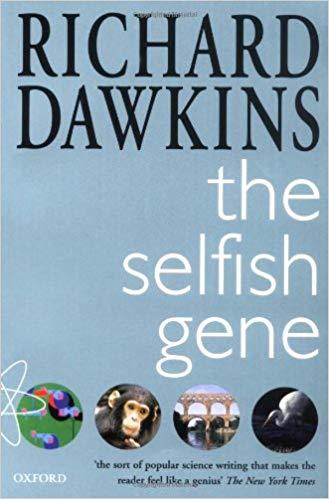 When researchers went to get a look at a cape cobra snake fight, it turned out to be one cobra swallowing another. They named the newly well-fed study animal NN011, otherwise “Hannibal.”
When researchers went to get a look at a cape cobra snake fight, it turned out to be one cobra swallowing another. They named the newly well-fed study animal NN011, otherwise “Hannibal.”
Apparently, “Diner, meet Dinner!” is not an uncommon relationship among cape cobras so a study of the details ensued:
Snake-eating, they found, was common among five of the six species studied, accounting for 13 to 43 percent of the cobras’ diets.
Four per cent of the snake dinners eaten were of the same species as the diner. One researcher reasoned,
In all the cannibalism events that the researchers witnessed themselves, both the eater and the eaten were males, leading them to suspect that this behavior may be a male-only trait. More research will be needed to determine if that’s true. But if it is, Maritz says, “I could see it playing a role in competition for resources or mates. What better way to get ahead in life [than to] eat the guy who is taking your food and mating with females that you might want to mate with?”Sarah Zielinski, “How a snake named Hannibal led to a discovery about cobra cannibalism” at Science News
Hmmm. If you read the story, you will note that researchers were surprised to learn how common cannibalism was among cobras and they had only witnessed a few events. Because those events involved only males, it was theorized that “this behavior may be a male-only trait.” If it is, then it is an argument in favour of the idea that the snake’s genes behave in such a way as to conserve and reproduce themselves. We would then need to figure out how they “know” how to do so.
But if it turns out that hungry females will eat other females, does that count against Maritz’s informal hypothesis? That is, can we determine that a selfish gene hypothesis is explicitly not correct? Or is it the sort of thing for which there can only be evidence in favor, never against?
Follow UD News at Twitter!
See also: Caterpillar “turns into” a snake Has anyone done probability calculations (not rhetoric or theorizing) for purely random evolution for this, via natural selection acting on random mutation (Darwinism)?
Copyright © 2018 Uncommon Descent . This Feed is for personal non-commercial use only. If you are not reading this material in your news aggregator, the site you are looking at is guilty of copyright infringement UNLESS EXPLICIT PERMISSION OTHERWISE HAS BEEN GIVEN. Please contact legal@uncommondescent.com so we can take legal action immediately.
Plugin by Taragana
Caterpillar “turns into” a snake
Larva of a sphinx hawk moth (Hemeroplanes triptolemus).
Hat tip: Digg
Also:
Has anyone done probability calculations (not rhetoric or theorizing) for purely random evolution for this, via natural selection acting on random mutation (Darwinism)?
Follow UD News at Twitter!
See also: Orchids with monkey faces and A moth’s wings feature two flies picking at a pile of bird dropping.
Has anyone established that these impostures “fool” any life form into avoiding the plant?
Copyright © 2018 Uncommon Descent . This Feed is for personal non-commercial use only. If you are not reading this material in your news aggregator, the site you are looking at is guilty of copyright infringement UNLESS EXPLICIT PERMISSION OTHERWISE HAS BEEN GIVEN. Please contact legal@uncommondescent.com so we can take legal action immediately.
Plugin by Taragana
Michael J. Behe's Blog
- Michael J. Behe's profile
- 219 followers



